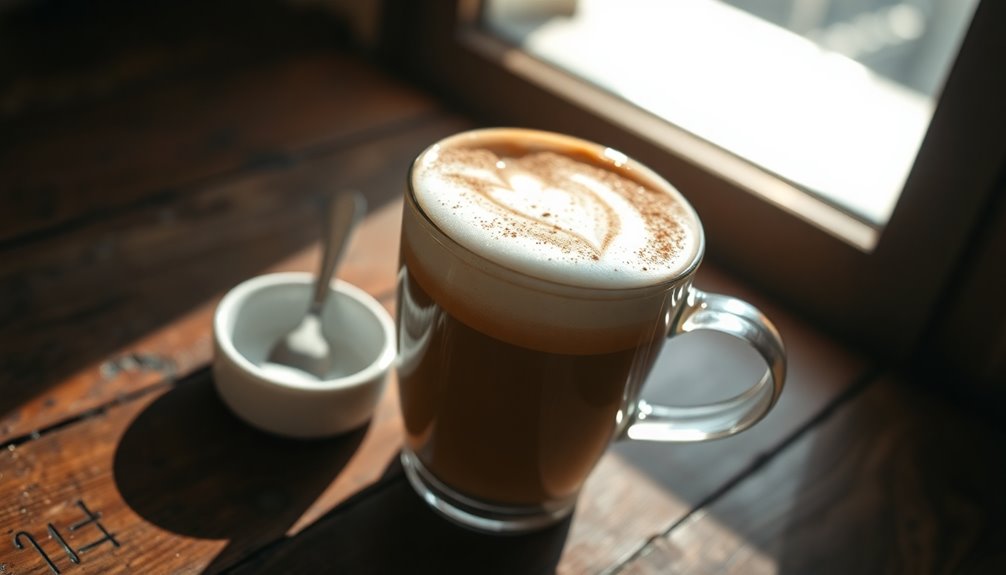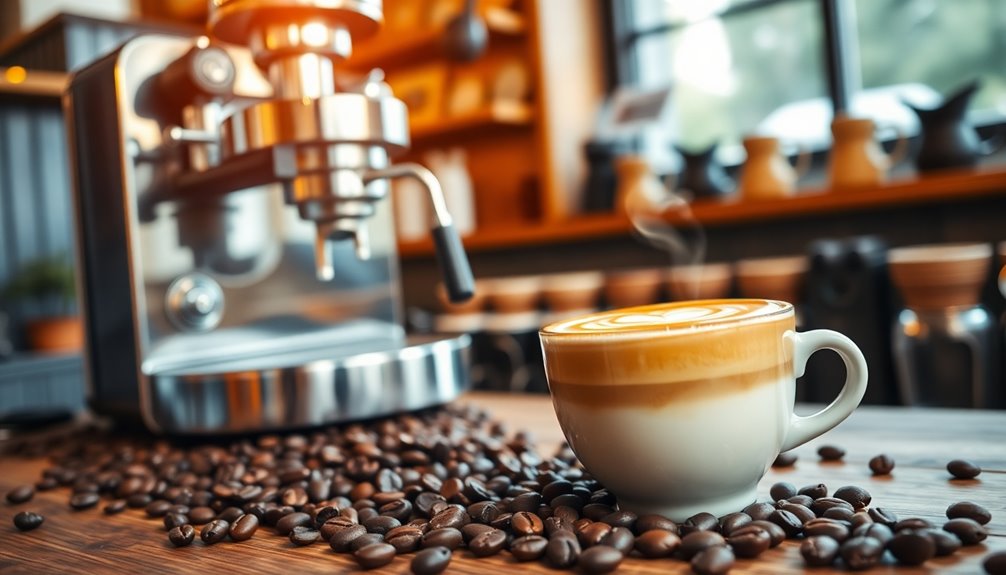Coffee's journey starts in Ethiopia with the *Coffea arabica* plant, where legends of Kaldi, the goat herder, highlight its energizing effects. It spread to the Middle East, sparking trade and culture. By the 17th century, coffee arrived in Europe, transforming social interactions in coffee houses. Colonial expansion made coffee a global commodity, while modern trends emphasize ethical sourcing and sustainability. There's so much more behind this beloved beverage, waiting to be explored further.
Key Takeaways
- Coffee originated in Ethiopia, where its energizing effects were discovered, leading to its cultural significance and social rituals.
- The spread of coffee to Yemen and then Europe in the 17th century transformed it into a popular beverage and social phenomenon.
- Colonial expansion established coffee plantations worldwide, intertwining global trade and cultural exchanges, while relying on enslaved labor.
- The rise of coffee houses during the Enlightenment fostered intellectual discussion and creativity, influencing modern social interactions.
- Today's coffee culture emphasizes ethical sourcing and sustainability, reflecting consumer awareness of the beverage's global impact and health benefits.
The Origins of Coffee: From Ethiopia to the Middle East
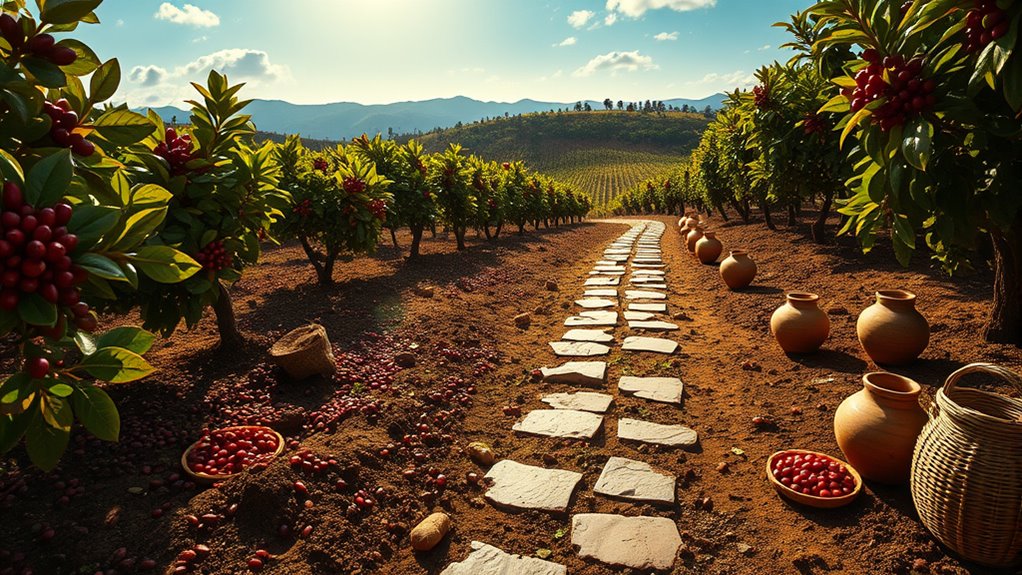
Although many enjoy coffee today, few know its roots trace back to Ethiopia, where the *Coffea arabica* plant originated. The legend of Kaldi, an Ethiopian goat herder, tells how he discovered coffee's energizing effects after noticing his goats' lively behavior.
Recent genetic studies affirm Ethiopia as the coffee's birthplace, tracing its lineage back between 610,000 and one million years. In Ethiopian culture, coffee holds significant spiritual and social importance, woven into daily life and traditions. Additionally, coffee's journey as a traded commodity significantly influenced its integration into various cultures, shaping social customs around the world. Notably, the emergence of coffee as a global phenomenon parallels the rise of essential accessories that enhance the coffee experience, such as grinders and brewing equipment. Understanding the brewing methods used across cultures has further enriched the appreciation of coffee.
Economically, it's crucial, providing substantial foreign income. As coffee spread to the Arabian Peninsula, particularly Yemen, it evolved into a traded commodity, becoming integral to local practices and social customs, paving the way for its global popularity.
Coffee's Arrival in Europe: A Cultural Shift
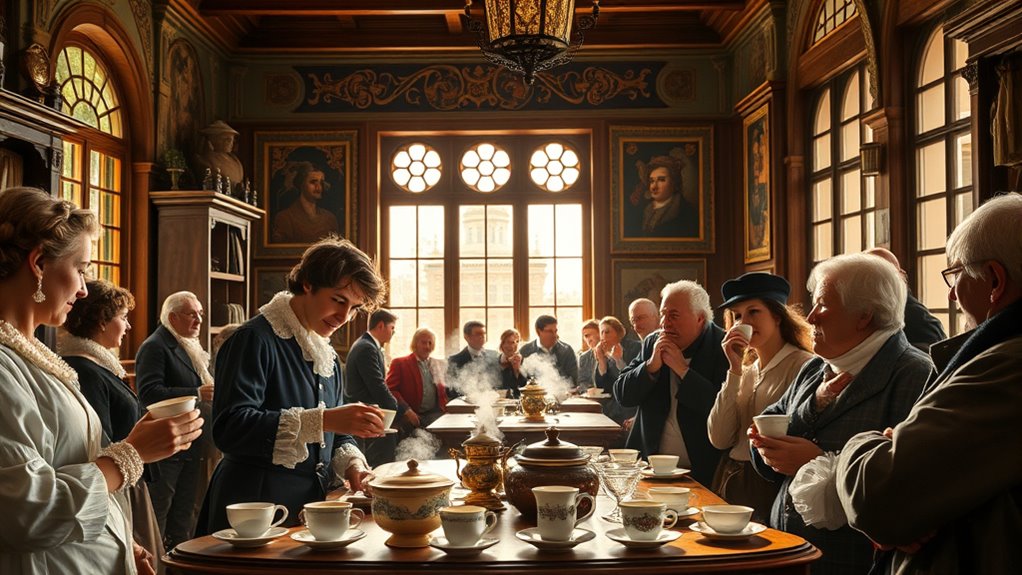
As coffee made its way to Europe in the early 17th century, it sparked a cultural shift that transformed social interactions and intellectual discourse. Introduced by travelers and traders, coffee quickly gained popularity, with the Venetians leading the charge in Italy.
Initially sold in pharmacies, its medicinal reputation faded as coffee houses emerged, modeled after those in Istanbul and Alexandria. These venues became vibrant hubs for intellectuals and artists, fostering lively discussions that fueled the Enlightenment. The rise of coffee culture also coincided with the emergence of sustainable fashion, as social gatherings increasingly reflected a blend of style and intellectual engagement. The coffee houses served as a precursor to modern-day French Press operation, promoting a communal coffee experience that encouraged deeper connections among patrons. Additionally, the interaction among patrons in coffee houses mirrored the community engagement seen in modern multimedia platforms, where diverse voices come together to share ideas and experiences.
The Colonial Era: Coffee's Global Expansion
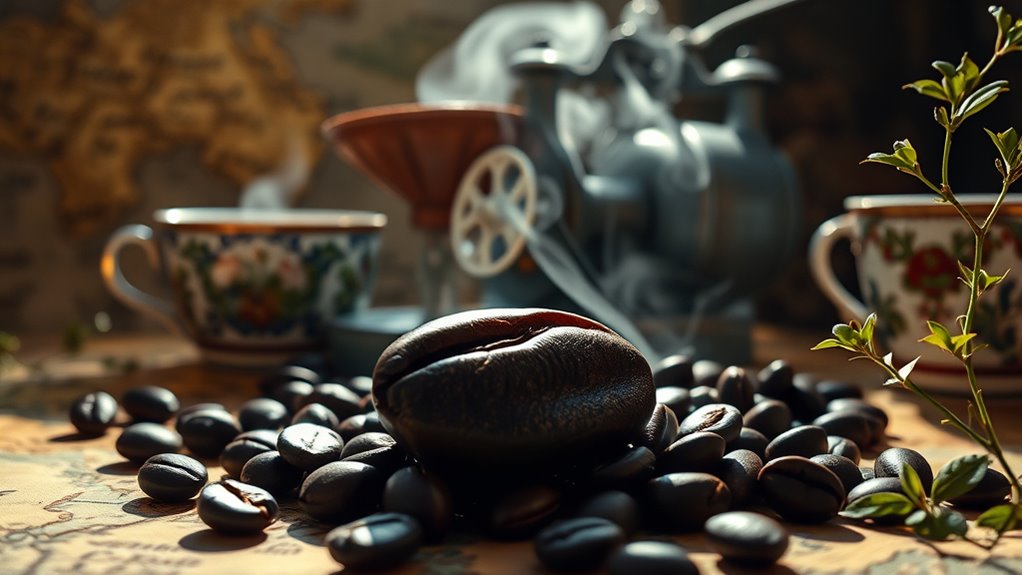
During the Colonial Era, coffee's expansion transformed it into a global commodity, connecting continents and cultures.
You'd see coffee spreading from Ethiopia to Yemen, quickly gaining popularity in Arabian cities like Mecca. European powers, especially the Dutch and French, established coffee production in their colonies across the Americas and Asia. This labor-intensive crop required significant resources and manpower, making it a central focus of colonial economies. The economic framework of these colonial ventures often relied on RMDs to ensure financial stability for landowners.
This labor-intensive crop drove economic prosperity, fueling complex trade routes that linked the Americas, Africa, and Europe. However, this expansion came at a cost: indigenous populations were displaced, and enslaved Africans became the backbone of coffee plantations.
As Brazil emerged as a leading producer, coffee rivaled sugar in the global market, shaping economies and leaving a legacy of exploitation that still resonates today. The rise of coffee cultivation parallels the growth of historical farm museums that preserve agricultural history and rural life.
The Rise of Modern Coffee Culture

While coffee has long been a beloved beverage, its transformation into a modern cultural phenomenon reflects the evolving tastes and values of society.
You'll find that coffee houses emerged as social hubs, fostering creativity and intellectual exchange during the Enlightenment. As they spread from the Middle East to Europe and eventually the U.S., they symbolized wealth and sophistication, shaping local cultures. Coffee consumption varies significantly across different cultures, further emphasizing its global appeal. Ethical sourcing practices have also become a crucial aspect of how consumers choose their coffee, indicating a shift towards greater awareness of global impacts.
The rise of specialty coffee shops introduced diverse flavors and brewing methods, turning coffee into an art form. Chains like Starbucks popularized coffee culture, making it a daily ritual for many.
Today, coffee isn't just a drink; it's a lifestyle that reflects personal preferences, creativity, and community engagement, solidifying its place in modern society. Additionally, the rise of specialty coffee has contributed to a growing focus on sustainability, mirroring trends seen in other industries.
Innovations in Coffee Production and Preparation

The evolution of coffee culture has set the stage for groundbreaking innovations in coffee production and preparation.
You'll find that early methods like sun-drying coffee cherries are still in use today, alongside wet processing techniques that emerged in the 1700s. Continuous butter making enables large-scale production techniques that have parallels in coffee processing, ensuring consistency and quality.
Mechanization has significantly increased efficiency, while honey processing adds a delightful balance of sweetness and acidity. Additionally, color accuracy in coffee roasting can greatly influence the flavor profile, much like how it affects image quality in home cinema projectors.
Mechanization boosts efficiency in coffee production, while honey processing enhances flavor with a perfect blend of sweetness and acidity.
Advances in roasting, from early Arab techniques to modern artisanal methods, allow for precise temperature control and unique flavor profiles. Brewing methods have also transformed, with inventions like espresso machines and the popular cold brew. Together, these innovations ensure that each cup of coffee you enjoy reflects a rich history of creativity and technological progress. Furthermore, the HEPA filter technology used in air purifiers demonstrates how advancements in other fields can also enhance our sensory experiences, including the enjoyment of coffee.
Contemporary Trends: Sustainability and Global Coffee Culture
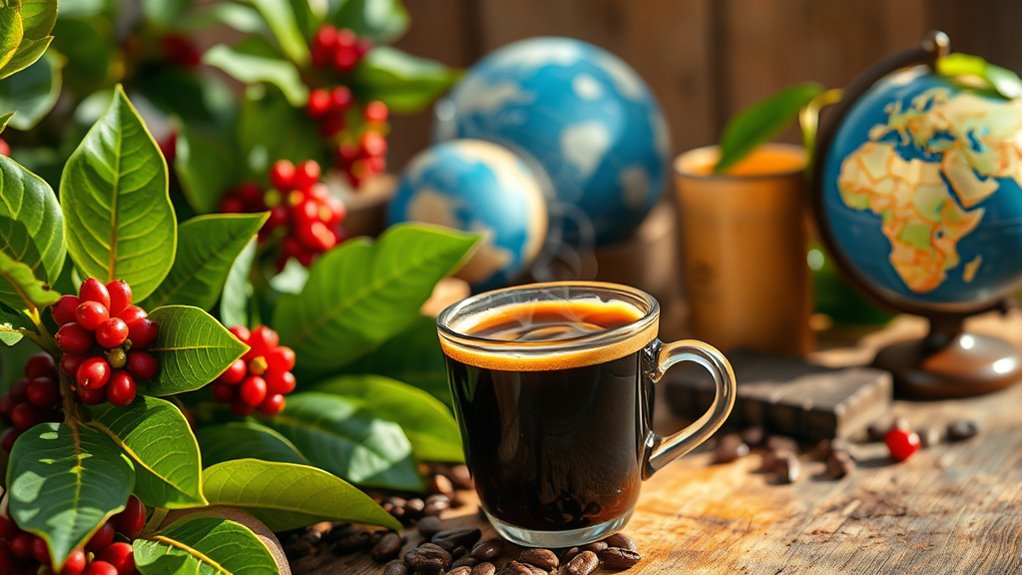
How has coffee culture evolved to embrace sustainability in today's world? You might be surprised to find that methods like shade-grown coffee are now popular, preserving biodiversity and reducing soil erosion. Organic farming practices enhance soil fertility without synthetic chemicals, ensuring safer conditions for farmers. Effective water management, including rainwater harvesting, helps protect precious resources. Additionally, the incorporation of cover crops can significantly improve soil structure and fertility, benefiting coffee plants in the long run.
Soil conservation techniques, such as terracing, educate growers on maintaining healthy environments, while the use of solar-powered technologies can further enhance efficiency in coffee processing. You'll notice a growing emphasis on fair trade practices, benefiting both farmers and local communities. As consumer demand for sustainable options rises, innovative solutions like solar drying technologies are emerging. This shift not only reflects changing values but also strengthens coffee's role in global culture, intertwining sustainability and social connection. Additionally, the use of dietary fiber in coffee-related products can support gut health, mirroring trends seen with ingredients like chia seeds.
Frequently Asked Questions
What Are the Different Types of Coffee Beans?
When exploring coffee beans, you'll find four main types: Arabica, Robusta, Liberica, and Excelsa.
Arabica's your go-to for delicate flavors and lower caffeine, making up 60-70% of production. Robusta packs a bitter punch with higher caffeine, while Liberica offers a unique fruity and floral aroma.
Finally, Excelsa, a variant of Liberica, brings a tart taste, often enhancing blends. Each type contributes to the rich diversity of coffee you enjoy every day!
How Is Coffee Decaffeinated?
Did you know that over 10% of coffee consumed globally is decaffeinated?
When it comes to decaffeination, you've got several methods. The direct-solvent process uses chemicals like methylene chloride, while the Swiss Water Process relies solely on water to remove caffeine.
The carbon dioxide method employs supercritical CO2, ensuring a chemical-free result. Each technique preserves flavors, so you can enjoy your cup without the jitters, keeping your coffee experience satisfying and safe.
What Are the Health Benefits of Drinking Coffee?
Drinking coffee offers several health benefits that you might find surprising.
It's linked to improved cardiovascular health, reduced mortality risk, and a lower chance of developing type 2 diabetes. You'll also benefit from its antioxidants, which protect against oxidative stress.
Consuming coffee in the morning can maximize these advantages, enhancing alertness and energy while keeping your calorie intake low.
How Does Coffee Affect Sleep Quality?
You might think that coffee keeps you energized, but its effects on sleep quality are sneaky.
Caffeine delays how quickly you fall asleep and can cut your total sleep time by nearly 45 minutes. You might find yourself in lighter sleep stages more often, while deep sleep slips away.
To keep your nights restful, consider having your last cup at least 8.8 hours before bedtime—your body will thank you in the morning!
What Are Popular Coffee Drinks Worldwide?
When it comes to popular coffee drinks worldwide, you can't go wrong with a cappuccino, which leads the pack in 24 countries.
Espresso follows closely, loved in 14 countries.
If you prefer something richer, black coffee is a favorite in 12 countries, while the Americano holds its ground in 10, especially in South America.
For a sweet touch, mocha delights coffee lovers in six countries, including Japan and Vietnam.
Conclusion
As you sip your morning brew, you're part of a rich tapestry woven through centuries. Imagine a bustling café in 17th century Vienna, where intellectuals debated ideas over their coffee. Today, that spirit lives on in local roasteries like Stumptown, where sustainability meets flavor. By supporting such brands, you're not just enjoying a cup; you're participating in a global movement that honors coffee's journey from a humble bean to a beloved ritual.



